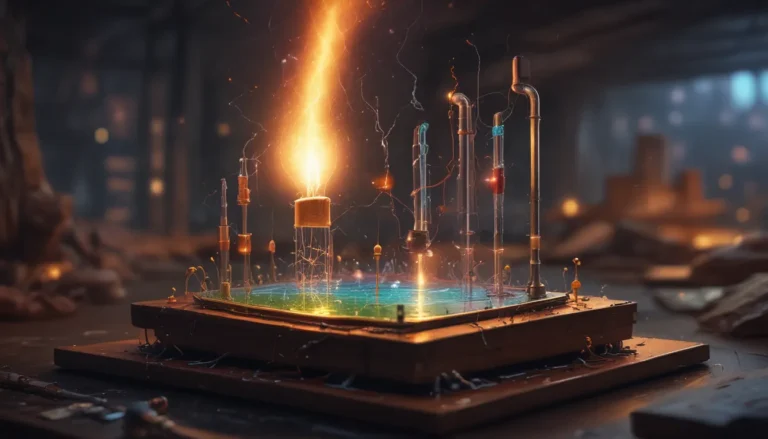A Note About Images: The images used in our articles are for illustration purposes only and may not exactly match the content. They are meant to engage readers, but the text should be relied upon for accurate information.
Are you intrigued by the mysterious behavior of electric charges and the principles that govern them? Dive into the captivating realm of the Law of Conservation of Charge, a fundamental concept in the field of chemistry that sheds light on the intricate nature of electricity and magnetism. In this article, we will unravel 11 astounding facts about this law that will deepen your understanding of its implications and significance in the world of physics.
Key Takeaways:
- The Law of Conservation of Charge states that electric charge can neither be created nor destroyed, only transferred or redistributed. This principle is crucial for understanding how electric charges behave and interact.
- Charge conservation is a universal principle that applies to all types of charged particles, from electrons and protons to subatomic particles. It plays a key role in various scientific fields and has far-reaching implications for our understanding of the universe.
The Fundamental Principle of Charge Conservation
The Law of Conservation of Charge, a foundational principle in physics, dictates that the total electric charge in an isolated system remains constant over time. This means that charge is neither created nor destroyed; it can only be transferred or redistributed.
Understanding Charge Quantization
Charge quantization, a key concept underlying the Law of Conservation of Charge, refers to the fact that electric charge exists in discrete units known as elementary charges. The elementary charge is the charge of a single electron or proton, with all other charges being multiples of this fundamental unit.
Symmetry in Physical Laws and Charge Conservation
The Law of Conservation of Charge is a consequence of the symmetry of physical laws. Electric charge is intricately linked to fundamental symmetries in nature, ensuring that charge is conserved in all interactions, whether through electromagnetic forces, nuclear forces, or particle interactions.
Exploring Electrostatics and Charge Conservation
Electrostatics, the study of stationary electric charges and their interactions, relies heavily on the Law of Conservation of Charge. This principle allows scientists to predict and analyze the behavior of electrically charged objects at rest, unraveling the mysteries of static electricity and electric fields.
Beyond the Basics: Charge Conservation in Circuits
In electrical circuits, charge conservation is paramount for ensuring the smooth flow of current and the proper functioning of electronic devices. This principle dictates that the total amount of charge entering a junction must equal the total amount of charge leaving it, maintaining the balance of electrical systems.
The Interplay of Charge Conservation and Electric Fields
The presence of electric charges gives rise to electric fields, which exert forces on other charges. By conserving charge, we can accurately calculate and predict the behavior of electric fields and the resulting forces, shedding light on the intricate nature of electromagnetic interactions.
Charge Conservation and the Conservation of Energy
Charge conservation is intricately linked to the conservation of energy, as electric potential energy depends on the distribution of charges. While charges may move and redistribute, the total energy in the system remains constant, highlighting the interconnected nature of fundamental physical principles.
Charge Conservation in Particle Physics
In the realm of particle physics, the conservation of charge is closely monitored in experiments to identify and understand the particles involved in interactions. This principle serves as a cornerstone for unraveling the mysteries of fundamental particles and their behavior.
Experimental Validation of Charge Conservation
Scientists have conducted numerous experiments across various contexts to confirm the conservation of charge with remarkable precision. The results consistently validate this fundamental law, reinforcing our understanding of the underlying principles that govern our physical reality.
Expanding Our Understanding of the Universe
The Law of Conservation of Charge has far-reaching implications that extend beyond the realm of physics. By intertwining with other conservation laws, such as the conservation of mass, energy, and momentum, charge conservation plays a fundamental role in shaping our understanding of the universe and the forces that govern it.
Conclusion
In conclusion, the Law of Conservation of Charge serves as a cornerstone in the study of chemistry, offering profound insights into the behavior of electric charges and their interactions. By delving into the intricate world of charge conservation, we can unravel the mysteries of electricity and magnetism, gaining a deeper appreciation for the fundamental forces that shape our reality.
FAQs
Q: What is the Law of Conservation of Charge?
A: The Law of Conservation of Charge states that the total charge within an isolated system remains constant.
Q: Are charges always conserved?
A: Yes, charges are always conserved within an isolated system, as dictated by the Law of Conservation of Charge. Charges can be transferred between objects, but the total charge remains unchanged.
Q: How is the Law of Conservation of Charge relevant in everyday life?
A: The Law of Conservation of Charge helps us understand various electrical phenomena in our daily lives, such as the functioning of electronic devices, the flow of electricity in circuits, and even the behavior of lightning and static electricity.
Q: What is the basic unit of charge?
A: The basic unit of charge is the elementary charge, denoted as “e,” which is the charge carried by a single electron or proton.
Q: What happens when charges are not conserved?
A: When charges are not conserved, it may indicate a violation of the Law of Conservation of Charge, which can occur in rare and extreme phenomena, such as certain particle interactions where particles with opposite charges annihilate each other.
Exploring the World of Electricity and Physics
The Law of Conservation of Charge unveils the fascinating world of electric charges and their behavior, offering a glimpse into the intricate forces that shape our universe. Whether you’re intrigued by the principles of electrostatics, circuits, or particle interactions, delving into the realm of charge conservation can deepen your understanding of the natural world and its underlying laws. Join us on a journey of discovery as we uncover the remarkable phenomena that define the world of electricity and physics, expanding your knowledge and appreciation for the forces that govern our reality.






